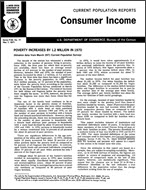Poverty Increases by 1.2 Million in 1970 (Advance data from March 1971 Current Population Survey)
Poverty Increases by 1.2 Million in 1970 (Advance data from March 1971 Current Population Survey)
The decade of the sixties witnessed a sizeable reduction in the number of persons living in poverty. Since 1959, the first year for which data on poverty are available, there has been an average annual decline of 4.9 percent in the number of poor persons. However, between 1969 and 1970, the number of poor persons increased by about 1.2 million, or 5.1 percent. This is the first time that there has been a significant increase in the poverty population. In 1970, about 25.5 million persons, or 13 percent of the population, were below the poverty level, according to the results of the Current Population Survey conducted in March 1971 by the Bureau of the Census. The rates of increase for both whites and Negroes below the poverty level were roughly the same. In 1970, however, the poverty rate for Negroes was more than three times that for whites.
A Note on Language
Census statistics date back to 1790 and reflect the growth and change of the United States. Past census reports contain some terms that today’s readers may consider obsolete and inappropriate. As part of our goal to be open and transparent with the public, we are improving access to all Census Bureau original publications and statistics, which serve as a guide to the nation's history.
Others in Series
Publication
Publication
Publication




